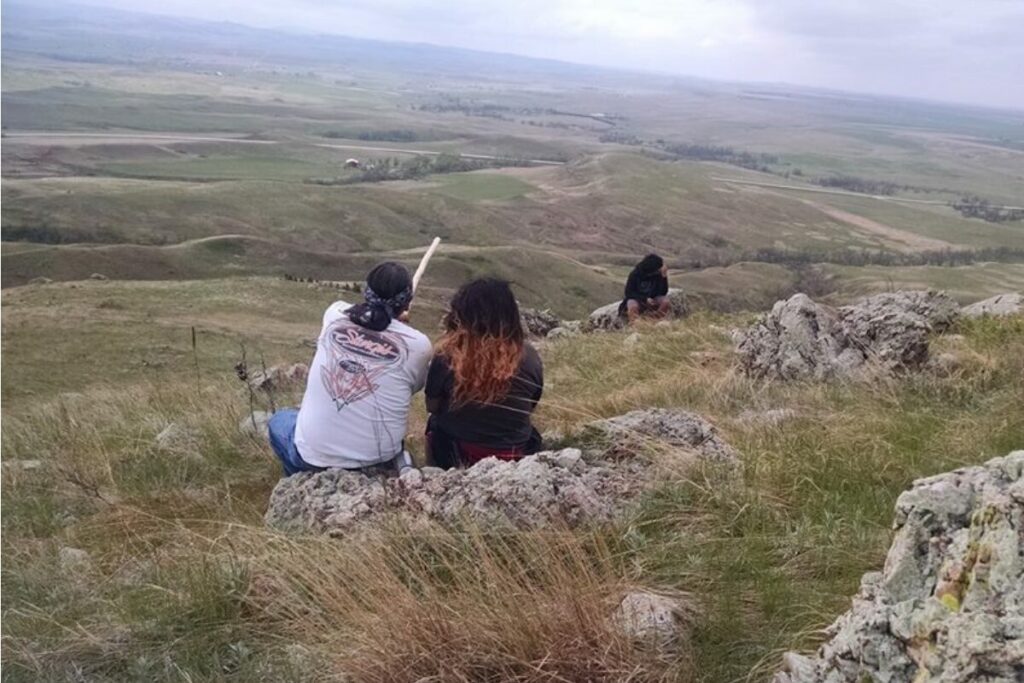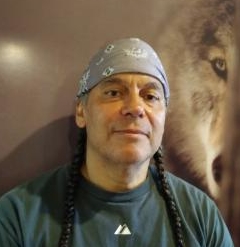Throughout the history of mainstream education, there’s been a pattern of displacing centuries of wisdom that is vital to learning—prioritizing the desire to train, rather than to educate and enlighten.
Joe Rice, Executive Director, Nawayee Center School
Throughout colonial history, Indigenous alternative schools have arisen as a response to an American educational system that was created in spite of Indigenous children and their families. Mainstream American schools, birthed in a worldview of colonization and with little or no connection to nature or the land, utilize a pedagogy emphasizing rote memorization and regurgitation of “facts.” They provide very little time for movement, self-discovery, or relational thinking—three essential ingredients of Indigenous lifeways.
As a result, “educational institutions” have often served as adversaries, rather than facilitators of learning, for Indigenous children. In fact, the mission of the earliest schools for Indigenous children—government-run boarding schools—was “Kill the Indian, Save the Man.” Their aim was to replace tribal culture with dominant “Americanized” culture.
The resulting high levels of disengagement among generations of Indigenous children has demanded that Indigenous alternative schools counter mainstream conventional education with more culturally contextualized learning to reclaim the wisdom lost during 10,000 years of global colonization.
I am honored to be working alongside impassioned Indigenous educators, who see our work as a labor of love, to help this vision be realized for young people in our community. We started by recognizing that our kids are active, relational learners, not passive recipients of knowledge, and then created an asset-based approach that aims to harness the many strengths of learners from an Indigenous cultural perspective.
Grounding Youth in Indigenous Lifeways
Since I began working at Nawayee Center School 20 years ago, we have focused on re-shaping our students’ educational experiences by empowering them to feel safe and welcomed. And, revealing to them that they are brilliant, powerful, and insightful learners capable of unlimited success. The primary methodology for doing this has been to incorporate Indigenous lifeways into every facet of our programming.
Indigenous lifeways are rooted in a coherent and magical understanding of the universe and an appreciation of this planet as our oldest living relative who provides everything we need to live in harmonious, practical, and pragmatic ways.
To understand Indigenous cultures means to be grounded by four facts. Indigenous cultures are:
- Autochthonous (they arise from the land);
- Informed and held together by relationships and relatedness;
- Ancient and part of an infinite universe and all that infinity implies; and,
- Continuously evolving, as are all living things.
Drawing from these truths, we are developing culturally relevant learning environments for our students based on five “Best Practices”:
- Teaching and learning happen co-creatively and within the context of culturally appropriate relationships;
- Learning experiences are much richer in potential when they are multi-sensory and draw from Indigenous cultural wisdom;
- Learning needs to encourage the growth of mind, body, spirit, and soul;
- Learning endeavors should address issues important to both learner and teacher; and
- Teachers must be good listeners.
These “Best Practices” inspire us to continually evolve together as a harmonious learning community.
At Nawayee, our most recent Trauma Informed Classroom initiative engages staff in a rigorous, healing-based training. The most salient takeaways of this training are that behavior is information (staff learn to observe students behavior and identify signs of trauma) and that intergenerational trauma is a health issue in Indian Country. The magic in doing this work is that our students and staff have transformed into a community of healers committed not only to addressing trauma but also to building resilience.
Addressing Trauma as a Multi-Disciplinary Approach
The intense intergenerational trauma experienced by Indigenous peoples of North America, which continues to disproportionately harm our children, also led us to develop our Medicine Wheel Health program—turning addressing trauma into an academic subject that was ultimately integrated with all other areas of study through a multi-disciplinary approach.
By making the investigation of intergenerational trauma foundational to how and what students learn, we create space for healing and the opportunity to give more historical context to the present. Through the study of History, Science, Language Arts, and Math, they gain distinct insights into the lived-experiences of Indigenous peoples in North America. This includes exploring the history of colonization, genocide, and their environmental implications; reading the narratives of Boarding School survivors; and examining relevant statistics to comprehend the horrific number of affected Indigenous peoples.
In response to this approach, students have become more engaged in their learning about these issues. They are now more empowered to help put today’s experiences in their proper context and take on the responsibility of finding solutions to problems in our community. Our students are challenging America’s narrative of adults and intellectuals as the most revered and respected leaders by stepping up to help us move forward as a people.
Learning Environments as Places of Peace and Gratitude
At Nawayee, student engagement, attendance, and graduation have steadily improved. But, more importantly, a quiet, respectful ambience now presides over our school. This is embodied in the overwhelming sense of peace among our students—a tangible truth our staff and others who enter our space can feel. It completely contrasts the emotionally detrimental feeling of detachment or indifference that too often pervades mainstream school communities.
Being physically separated from our tranquil community (and each other) has been the most difficult aspect of the COVID-19 crisis. We are unable to offer many of the aspects of our learning environment that our students enjoy and need the most. They miss the one-to-one conversations, the calm atmosphere of 65 people in a small building peacefully coexisting, the sound of friendly voices, and the spirit of a living culture.
An emotional connection to your learning and where you learn is missing from much of mainstream education. And, while we are temporarily apart, our gratitude for each other and the Indigenous lifeways that sustain our community remain with us.
How Indigenous Lifeways Can Transform Education
Where once the entire world was Indigenous, it is now mostly colonized, save for a few small pockets of Indigenous culture who hold on to the ancient wisdom of how to live in and care for this world.
This is nothing short of a tragedy. As Daniel Quinn remarked, “…every time the Takers stamp out a Leaver culture, a wisdom ultimately tested since the birth of mankind disappears from the world beyond recall.”
Throughout the history of mainstream education, there’s been a pattern of displacing centuries of wisdom that is vital to learning—prioritizing the desire to train, rather than to educate and enlighten.
By incorporating Indigenous lifeways into mainstream education, there exists the potential to shift our focus away from compliance-based pursuits of knowledge and move toward collective healing, seeking wisdom, and building relationships. Much can be learned within the context of stronger relationships, and very little is authentically learned without them. Measures would need to be taken that would reflect this new focus, such as smaller schools and smaller class sizes, a reduced emphasis on easily quantifiable measures of progress, and an overall trust in the human ability to learn and adapt.
A new vision for education is needed, rather than another set of “new” programs.
Students must have the freedom to choose what they want to learn and be mentored in the art of learning. And, they must be guided to continually identify and develop their skills and strengths. It takes wise, patient, and insightful adults to do this for children. Adults must focus on building meaningful relationships with their students, identifying what interests spark joy and curiosity in a child, and be creative enough to encourage the growth of that spark.
This is not a pedagogy that can be hastily introduced but one that must be thoughtfully considered and designed. It will require the support of educators, young people, families, and others who are passionate about inventing a more harmonious, culturally relevant, relationship-oriented future for education.
By embracing Indigenous understandings of learning and of the relationship between the world and the human mind, body, spirit, and soul, we have the power to create a transformative future for education and learning in communities everywhere.

